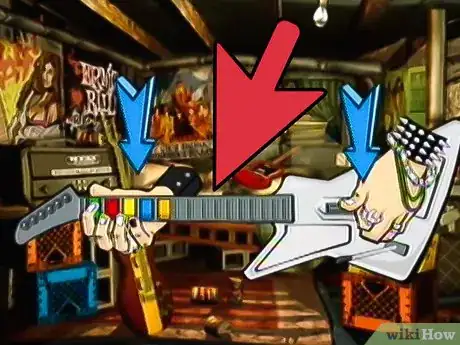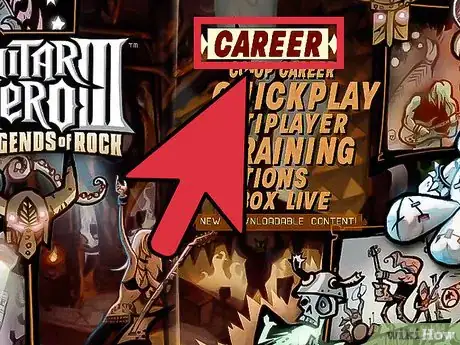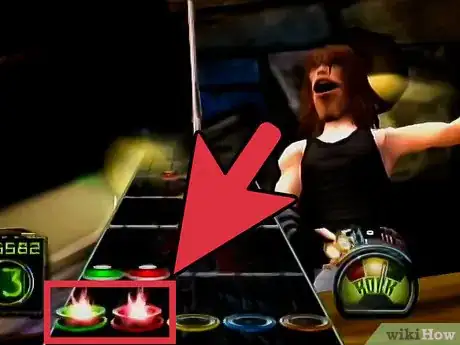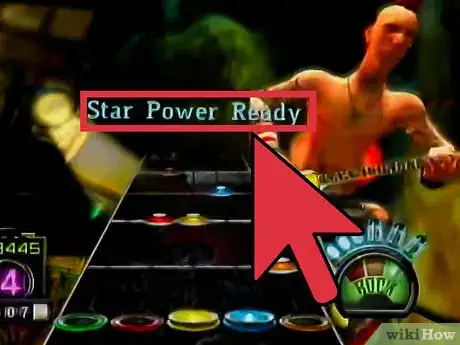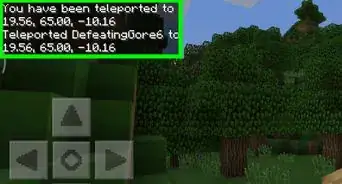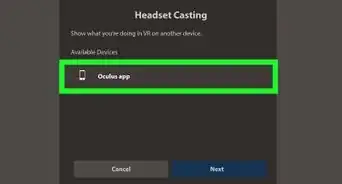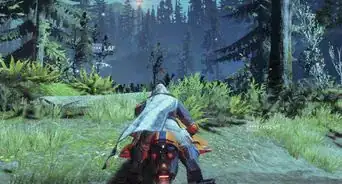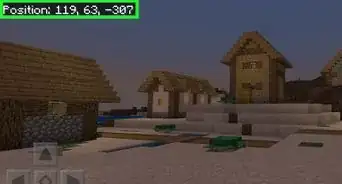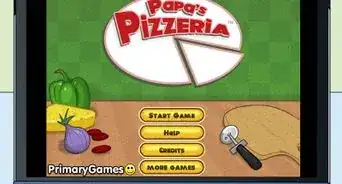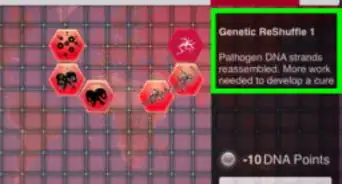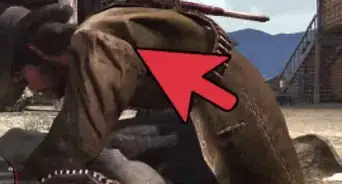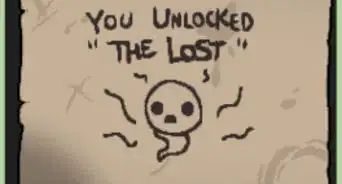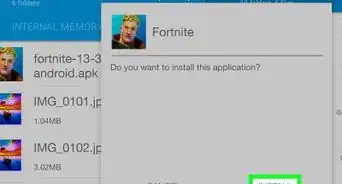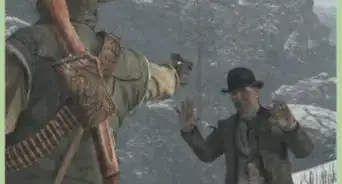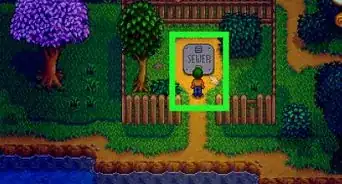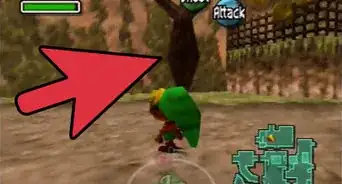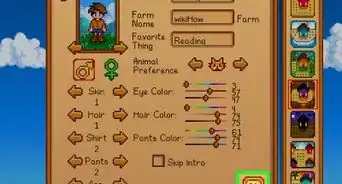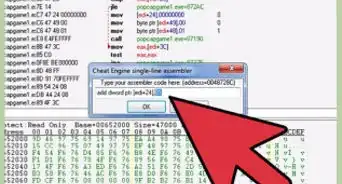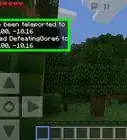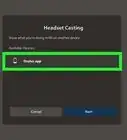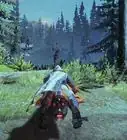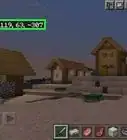wikiHow is a “wiki,” similar to Wikipedia, which means that many of our articles are co-written by multiple authors. To create this article, 111 people, some anonymous, worked to edit and improve it over time.
This article has been viewed 664,678 times.
Learn more...
Guitar Hero is a rhythm-based game for the PC, PlayStation 2, Nintendo Wii, PlayStation 3, and Xbox 360. You play a "guitar" in time with many well known tracks. Playing requires nothing more than a sense of the music's beat, a small degree of patience, a love of at least a few of the songs present, and most importantly - ludicrously dexterous fingers (a skill which can be acquired).
Despite the Guitar Hero guitar being a much simplified version of a real guitar, playing can still be nearly impossible - especially at higher difficulty levels.
Do you want to become a Guitar Hero? This how-to addresses a number of the playing techniques that you will need to use, and approaches play from a beginner level up to expert.
Steps
-
1Get to know your guitar - while not being nearly as complicated nor as big as an actual electric guitar, your mini-guitar has sufficient features to make it a real challenge to play. First and foremost is the strum bar, the two-directional switch in the center of the guitar. You push or pull this up or down in order to play a note. The note which you play is determined by pressing some combination of the five fret buttons on the guitar's neck. They are colored for quicker identification. Near the strum bar is a whammy bar, a small stick which you can move in order to modulate the sound produced by an extended note. Finally, the usual Start and Select buttons from normal controllers have been formed as fake volume and tone knobs. Just don't try to turn the volume down with them.
- If you're right handed, use your left hand to hold the guitar's neck with your three or four fingers placed over each of the fret buttons; keep your right hand on or near the strum bar. Left-handed people may just do the opposite, though you will also have to accommodate the whammy bar.
- If you play sitting down, then you can rest the guitar in your lap; but if you want to play standing up, you will probably want to use the strap provided.
- Take a while to get used to holding the guitar comfortably, something that you may find yourself doing a lot!
- If you want, personalize your guitar using the stickers provided with the game. It's your instrument!
-
2Start up the game - Connect the guitar to your console. Turn on your TV, your console, your sound system (if applicable) and put the game disk into the disk tray. If you're using a Playstation 2 to play, you'll probably want to use a memory card to save your high-scores and unlocked songs.
- If you're playing career mode for the first time, you need to come up with a name for your band. Be as inventive as you like, it isn't the most important decision that you'll ever make.
- The main option screen will give you a number of options: Career, Quick Play, Multi-player, Training and Options.
- Career is where the bulk of the game's fun lies - playing up to 35 songs across four difficulty levels allow you to accumulate cash, kudos and fame; the completion of each set of songs increasing your status, allowing you to play at a new venue and unlock a new set of five songs. Your earnings allow you to "purchase" unlocked options such as new guitars, songs and characters.
- Quick Play allows you to play any of the songs that you have unlocked on Career mode (10 are unlocked by default) at any difficulty level as a single experience. It includes a high-score table.
- Multi-player will be unavailable unless you have two controllers plugged in. It is possible to use a standard controller with Guitar Hero if you really want to. A second guitar controller is available individually, or else a friend may also have the game whom you can play with. In Guitar Heroes 2 and 3, there are multiple modes of play. Face-off splits the songs notes between two players (like the legacy Guitar Hero 1 play), while Pro Face-off allows both players to play the song as they would in Quick Play mode. Guitar Hero 3 also features a "battle" mode, where you use "battle power" to try to make the other player fail the song.
- Tutorial is a great introduction to how to play the game; giving you experience with playing the simplest of notes outside of the pressure of a full song. There are multiple tutorials, and it's recommended that you play through each tutorial sequentially. This how to introduces play from first principles and, though playing the tutorials is certainly beneficial and more visual, this guide assumes that the player hasn't.
- Options - important if you have wide-screen or need to change something. A very important option here is lefty-flip which you will want to turn on if you are left-handed and pressing the fret buttons with your right hand - it will make reorient the notes on the screen to your perspective.
Advertisement -
3Play.
- The best way to get used to playing is by having a crack at a song; and the simplest songs are the songs at the very beginning of the set list. If you already have a good sense of rhythm or musical background, you should try playing the Medium difficulty level first. Easy will likely be TOO easy for you. Start playing by going to the main menu and selecting "Quick Play" or "Career" and then choose the first song in the set list.
- After a loading screen which will consist of a helpful message and last few words of advice, which could either be pertaining to playing the game or entirely unrelated; you will be greeted by a spiraling view of the venue that you're playing in, the band that you're a member of and your (randomly selected, if playing Quick Play) avatar holding a guitar. A board will then appear in the lower middle of the screen, along with two structures in the lower corners.
- The main bit, and the key to your success, is the scrolling fret board in the middle of the screen. On this, notes are positioned with colors corresponding to the colors of the fret buttons on your guitar; their position on screen also reflects their position on the neck (i.e. the green key will always scroll down on the far left of the board - or right if lefty-flip is on). At the bottom of the screen are a number of unsaturated colored circles; pressing one of the fret buttons lights up the corresponding circle.
- On the lower left is your score, and "score multiplier". You receive a certain number of points for each note you hit, but stringing together 10 successive notes will increase your score multiplier so that you get twice as many points per note. This increases up to a 4x bonus. If you miss a note, the multiplier is reset to 1x.
- The lower right has a meter which shows the crowd's opinion of you. A needle will swing to the green when you're playing well and the crowd is loving you. The needle will swing into the red when you're playing poorly. If it goes too far into the red you will get booed off of the stage and have to restart the song. Above the meter is a bar which is your "star power" indicator - this is explained later.
- On Easy mode, only the green, red, and yellow buttons are used. On Medium, the blue button is added. On Hard and Expert difficulties, all five colored buttons are used.
- Colored notes will begin to scroll down from the top of the scrolling fret board. When you see the first note, hold down the corresponding fret button. When the note reaches the bottom of the screen level to the greyed out circles, strum using the strum bar. For each successive note, strum again. Other notes are played in exactly the same way: you press the corresponding buttons and strum when the note reaches the bottom of the screen - using the music's beat and melody will help you gauge when to play. Distilled to its most basic level - that's all there is to this game, strumming in time to the note while using the fret buttons to play the appropriate note. If you play too late or too early, you'll "miss" the note, hear a ghastly noise, and lose some popularity.
- This will be extended by playing chords: here you have to press two or more of the fret buttons instead of one. Again, the buttons you press correspond with those denoted on screen.
- Long notes are notes where the note is sustained after it has been played. They are denoted by a colored line trailing a note down the screen; and are played by holding down the appropriate fret button until the line has passed. After playing its initial note, you do not need to strum again. Instead, you can use your strumming hand to operate the whammy bar and distort or sustain.
- That's it! Play the notes that are requested on screen. Don't be put off if you fail on your first few attempts, because it takes a while to get used to playing competently. Working through songs progressively, regardless of how badly you feel that you are doing, and how low the scores you scrape through with are, will make you better - even though you don't realize it. As soon as you feel confident that you can string a few notes together, hop onto career mode and play through some songs. They won't be any harder here.
-
4Advanced techniques - there are a number of advanced techniques that you can use:
- Star Power, alluded to above, as a quality which you increase if you play all of the notes successfully in a series of "star notes". These notes appear in the shape of spinning stars rather than circles, and often appear in the more grandiose pieces of music. If there is a long star note, using the whammy bar on this will give you extra star power. Try to nail these if you can! If you get enough of it (the meter fills up beyond its mark), you can "use" it and enter star power mode by briefly tilting up your guitar or pressing the Select button. This will temporarily double the points that you get from each note, and drastically increase the rate that your popularity rises; so try to use it when there are lots of consecutive notes. Also, once you enter Star Mode, there is no exiting it until the power meter drains out, so wait until there are notes coming up or your Star Power will be wasted. You can also use Star Power to help you get through tough parts of songs that you can't get through otherwise.
- Hammer-ons and Pull-offs, Looking closely at the notes moving up the screen, you'll see that some notes are different than others. Normal notes have a hollow, black center, while "hammer-on" notes have a filled-in, white center. To simulate real guitar playing, some sequences of notes can be played by hammering-on or pulling-off: Simply strum normally for the black-center note (the first note in the sequence), and just press the correct button for the filled-in notes at the right time. "Hammer-on" notes will register as correctly played as long as you time it correctly. Try to perfect this technique, since eventually, on the most difficult songs, notes become too fast and close together to strum accurately.
- Whammying, If you can hit long notes, then you can use the whammy bar. On long notes (sustains), move the whammy bar up and down. Make sure you whammy on the star power sustains, you'll get more Star Power in your meter! Whammying does not give you any advantage on normal held notes, it's just fun to do.
Community Q&A
-
QuestionAfter my score is displayed, how do I continue playing without starting all over?
 Community AnswerUnfortunately you can't. Once you finish the song you're forced to either restart, leave to the main menu, or if you're doing a set or career then you continue the set.
Community AnswerUnfortunately you can't. Once you finish the song you're forced to either restart, leave to the main menu, or if you're doing a set or career then you continue the set.
Warnings
- Remember it is nothing like the real thing or as satisfying!⧼thumbs_response⧽
- Using any form of self-illuminated display in low lighting for extended periods of time may cause eyestrain and/or headaches, but has not been proven to cause any permanent damage.⧼thumbs_response⧽
Things You'll Need
- Some sort of display you can connect your console to (TV, computer monitor, etc)
- A Playstation 2, Xbox 360, PC or Mac, or for the third or fourth game a PS3 or Wii.
- A Guitar Hero, Guitar Hero II, Guitar Hero: Rock the '80s, Guitar Hero III, Guitar Hero: Aerosmith, Guitar Hero: Metallica, Guitar Hero World Tour, Guitar Hero Smash Hits, Guitar Hero 5, Band Hero, Guitar Hero Warriors of Rock, Rock Band, Rock Band 2, Rock Band: AC/DC, Rock Band Track Pack, The Beatles: Rock Band, or Rock Band 3 game disc.
- A guitar controller or standard console controller (although the page is for the Guitar Controller).
- Patience. Mastering the Expert difficulty might take several months, especially when it comes to harder songs by bands like Slayer and Dragonforce.
